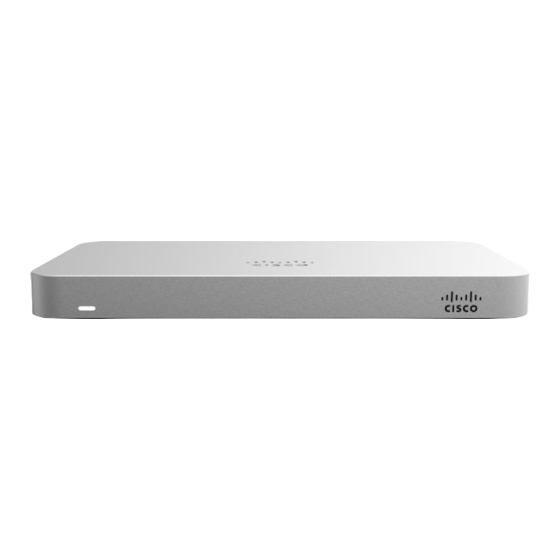
Table of Contents
Advertisement
Advertisement
Table of Contents

Summary of Contents for RingCentral Meraki MX64
- Page 1 Meraki MX64 Firewall/Router QoS Configuration Guide...
-
Page 2: Table Of Contents
Configure Your Firewall ....... . . 4 Meraki MX64 Firewall Configuration ..... . -
Page 3: Introduction
Meraki MX64 | Introduction Introduction Performance and Capacities Ideal for small size businesses The Meraki MX64 Security Appliance is ideal for organizations considering a Unified Threat Management (UTM) solution, for Recommended user count — 50 distributed sites, campuses or datacenter VPN concentration. -
Page 4: Configure Your Firewall
To review the Quick Start Guide for the Meraki click here. See the Meraki Installation Guide here. Log into the Meraki Cloud interface.. Select Security Appliance. (Figure 1) Figure 1 Select Firewall (Figure 2A) and Include the 7 RingCentral Supernets per the: RingCentral Recommendations and Requirements Document. - Page 5 QoS Configuration Guide | Meraki MX64 | Configure Your Firewall Figure 2A Figure 2B...
- Page 6 QoS Configuration Guide | Meraki MX64 | Configure Your Firewall Go Back into Security Appliance and select Traffic Shaping. (Figure 3) Figure 3...
- Page 7 QoS Configuration Guide | Meraki MX64 | Configure Your Firewall Set the Uplink configuration for the bandwidth which your circuit is providing for each WAN link. (Example circuit 5 Mbps and no WAN 2 or Cellular.) (Figure 4) Figure 4 If utilizing WAN2 and Cellular assure the devices are utilizing only one Network on one subnet and you are not load balancing or traversing between Wired and/or Cellular Networks.
- Page 8 (Figure 5) Figure 5 Set a Traffic shaping rule: (Figure 6) Rule #1. Set bandwidth management (BWM) for the RingCentral Supernets. Bandwidth limit set to “Ignore network per-client (unlimited). iii. Priority set to “High”. DSP tagging set to “46 (EF - Expedited Forwarding, Voice).
-
Page 9: Quality Of Service
Safari version 6.2 or higher (Mac) quality, with sufficient dedicated bandwidth to voice calls being the biggest factor. To help you manage your call quality, RingCentral offers tools to Note: check your internet connection speed, and instructions to configure the Quality of Service (QoS) settings of your routers. -
Page 10: Test Your Connection Quality
RingCentral. A two-minute test is typically sufficient, while longer tests are useful... -
Page 11: Ports And Firewalls Settings For Ringcentral Voip Service
Also see information on Port Triggering on the referenced page. ©2018 RingCentral, Inc. All rights reserved. RingCentral and the RingCentral logo are registered trademarks of RingCentral, Inc. Other third-party marks and logos displayed in this document are the trademarks of their respective owners.
Need help?
Do you have a question about the Meraki MX64 and is the answer not in the manual?
Questions and answers